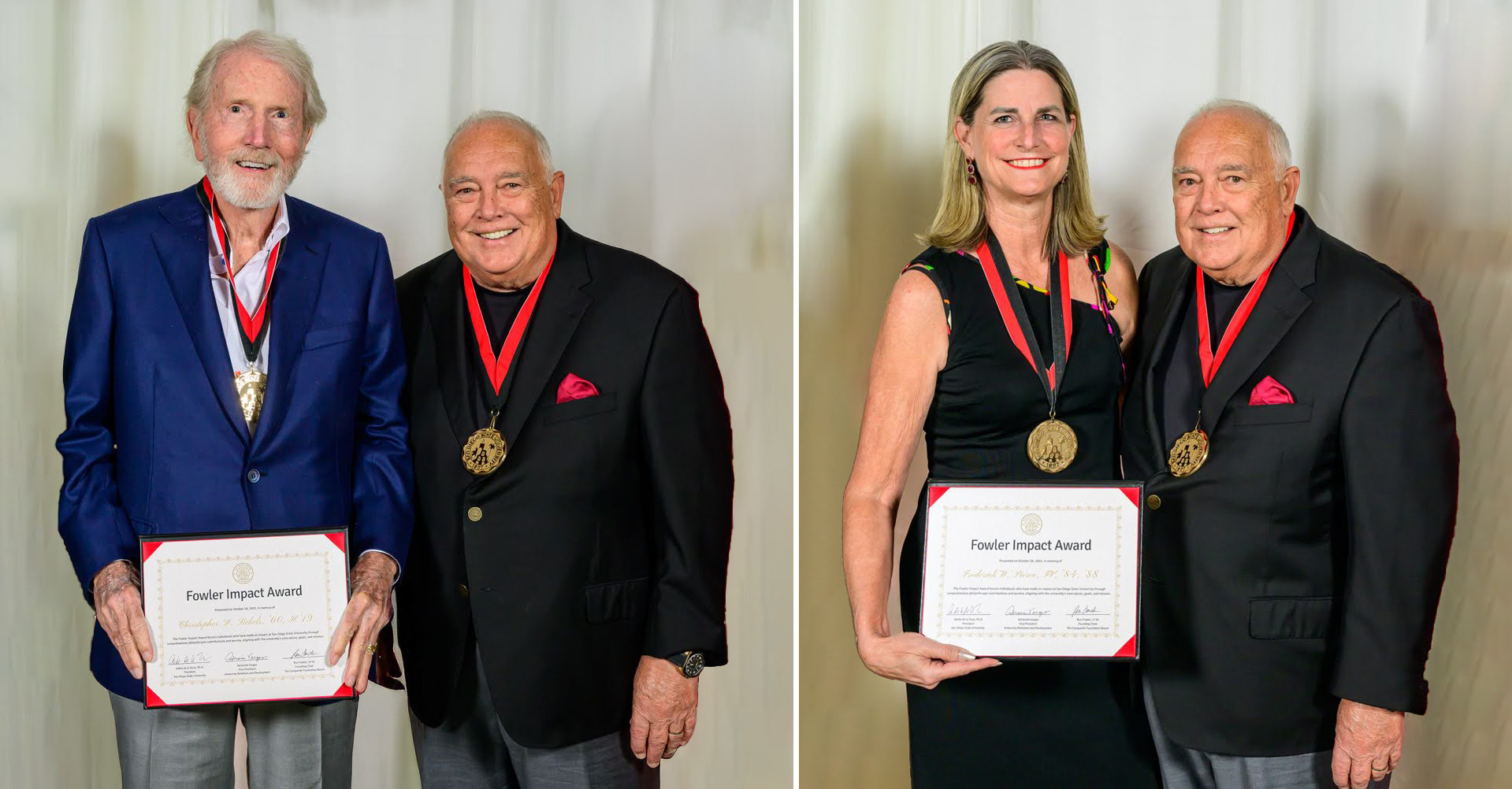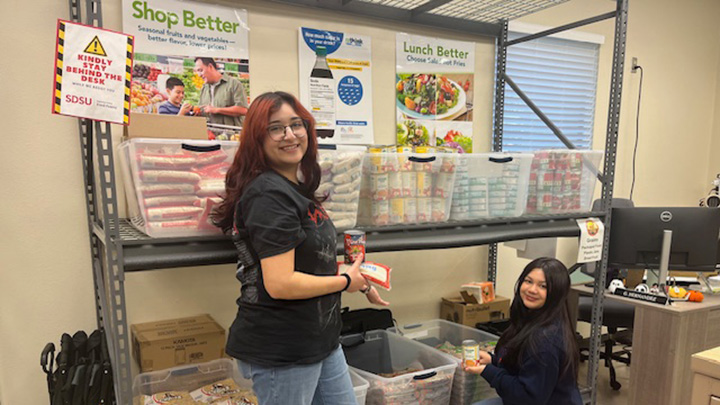Inside SDSU's Community COVID-19 Efforts
From contact tracing to testing and vaccine rollout, researchers pivoted quickly, launching critical programs to help San Diegos hardest hit groups.
When Mari Arcadio Arce speaks to Latinx community members, she finds most of them want to get the COVID-19 vaccine but may have trouble navigating the appointment system. A community health worker with Communities Fighting COVID!, Arce is on the frontlines of San Diego State University’s contact tracing program, launched last summer.
In eight months, her role has expanded from making calls and home visits to close contacts of people infected with the SARS-CoV-2 virus, to helping them understand the importance of getting vaccinated and making vaccine appointments.
When the pandemic began a year ago, SDSU’s public health experts worked closely with the County of San Diego’s Health and Human Services Agency (HHSA) to design a contact tracing program focused on the hardest hit groups — Black as well as Spanish-, Arabic- and Tagalog-speaking communities. The intention was to recruit and train community health workers (CHWs) as tracers drawn from the very communities they would serve, so they spoke the same language and understood the cultural nuances.
Since then, the university has rolled out programs for mobile testing, vaccine outreach and nursing student volunteer vaccinators, with each effort focused on underserved communities that face barriers to access for testing and health care, and grapple with mistrust and fears that cause vaccine hesitancy.
"When COVID-19 began, our researchers pivoted quickly to help the community," said Hala Madanat, interim vice president for research and innovation and a health disparities researcher. "We were able to do this mainly because of our longstanding relationship with local communities and the county, which is built on many years of trust and our understanding of the importance of community health workers."
Tracers offer extensive help
SDSU’s contact tracers make calls asking people to quarantine, connect contacts with community resources for rental assistance and counseling, make home visits with food drops and spot testing for COVID-19, and offer vaccine information.
The program has been so effective, the county now refers contacts it has been unable to reach to SDSU’s tracers.
“We’ve been able to reach 80% of the contacts that the county could not by sending our tracers into the community and speaking to them about the importance of quarantining,” said Corinne McDaniels-Davidson, director of the SDSU Institute for Public Health, who oversees the tracing program. The CHWs provide a critical feedback loop from the frontlines to meet the evolving needs of the communities served.
Often, witnessing the overwhelming need within the communities can take a toll, so program managers also address the emotional stress CHWs may experience.
Since August, SDSU’s tracers have made roughly 39,000 calls and contacted more than 9,000 people. This is in addition to referrals for the most vulnerable cases, with each case involving multiple family members. The majority of these efforts continue to focus on San Diego’s Latinx residents who are three times more likely than white residents to catch the virus.
“Our CHWs are grateful they’re able to make such a difference in people’s lives,” McDaniels-Davidson said. “Hearing the relief in people’s voices when they offer them assistance is so fulfilling. And for the contacts, getting a call from someone who speaks their language makes all the difference.”
After vaccines went into use early this year, CHWs urged contacts released from quarantine to take advantage of them; tracers have been following up with past contacts to schedule vaccine appointments through the county’s Project SAVE. SDSU tracers also set up tables at county vaccination sites, and help walk-ins schedule appointments.
Mobile testing sites in low-income communities
Modeled on the strategy for tracing, public health faculty led by testing expert Susan Kiene rolled out a COVID-19 testing program last fall. With the help of a $5 million grant from the National Institutes of Health, it employs bilingual community health workers who set up mobile testing sites in southeastern San Diego County.
“Our goal is to ensure people feel comfortable for what can be a stressful experience,” said Kiene, professor of global health and associate director for research in the School of Public Health. “This is where we differentiate from the mass testing sites, because our CHWs can speak their language, and focus on establishing a connection and building trust.”
The grassroots effort, hosted at churches and community organizations in Encanto and Imperial Beach, enables people to walk in and get tested for free in their own neighborhoods. Testing sites are expanding to El Cajon and Chula Vista next week.
“We’re starting to see a critical mass of people who come back to get tested regularly, and we’re reaching out to people who have high risk of exposure because of work or living conditions,” Kiene said.
The mobile sites are finding 21% positive rates, compared to the county, which sees an average of 4% to 5%, spotlighting the high case rate in these hardest hit areas.
Outreach to the local communities takes many forms, from radio ads in Spanish, to mailers in Tagalog, flyers placed with area businesses and word-of-mouth and in-person canvassing by CHWs. For those unable to make it to the mobile sites, the program also makes home visits in partnership with SDSU’s contact tracing program to provide testing to entire households and extended families.
The program uses the Quidel Sofia rapid antigen test developed by a San Diego biotechnology company on site, and positive results are put through a second round of polymerase chain reaction (PCR) lab tests for confirmation.
CommuniVax for equitable vaccine roll out
While there are widespread efforts underway for vaccine education and outreach, a national group recognized the need for nuanced communication tailored to address specific fears, mistrust and misinformation in underserved Black, Indigenous and Latinx communities.
SDSU has joined a select group led by the Johns Hopkins Center for Health Security and Texas State University, which will rely on grassroots input from several locations including San Diego, to investigate the reasons people hesitate to get the vaccine. The coalition, called CommuniVax, is funded by the Chan Zuckerberg Initiative.
The local effort is led by anthropologist Elisa Sobo and public health researcher Noe Crespo, whose work focuses on Latinx health promotion. Employing SDSU students and community health workers, the program focuses on listening to the concerns of San Diego’s Spanish-speaking community and sharing that feedback with the national group and local agencies, health care providers and pharmacies that will administer the vaccine.
.Misinformation in social media “makes it difficult to navigate through it all and sort out what is true,” Crespo said. “As a border region, with residents who go south and others who come up north for health care, we are learning that perspectives and information can vary widely.”
Having three different vaccines with varying doses and effectiveness adds to the uncertainty people experience.
“It’s a very confusing time for people now,” Crespo said. “Even for those who want to get the vaccine, we’re learning that the systems in place to book an appointment are not easy to navigate, or many of them can’t go online, which creates barriers.”
County data shows that among those who have received the vaccine so far, more than half are white, while Latinx residents represent roughly 20% of those vaccinated, although they account for 39% of the population.
Crespo said, “So far access is not yet equitable across different subgroups, and we need to simplify and fix the process to access the vaccines.”


